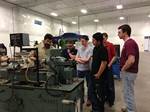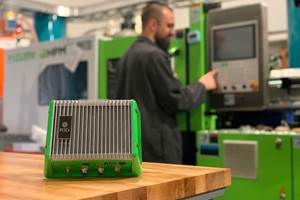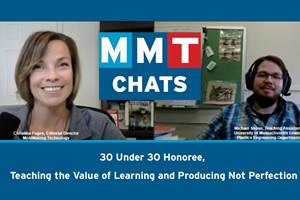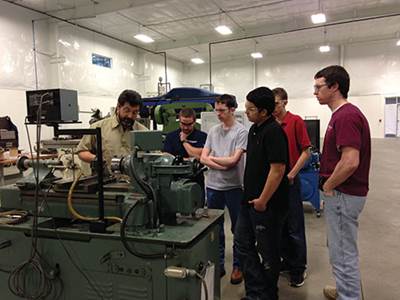A Proven Model for Apprenticeship
Steve Rotman, president of Ameritech Die and Mold, sheds light on his experience as one of the founding members of an apprenticeship program that has been churning out skilled workers for his shop and others since the mid-1990s.
Robbie Earnhardt, president of Superior Tooling, says he is confident that the North Carolina Triangle Apprenticeship Program (NCTAP) will help provide his shop with skilled workers for years to come. As yet, however, it’s too early for the company to have formally accepted any apprentices at all, let alone spent the time and money required to take one all the way through the four-year program. So, what makes him so confident? The fact that NCTAP is essentially a copy of Apprenticeship 2000, a different program that has been delivering results in another portion of the state for nearly 20 years.
Both programs aim to succeed through a structure that combines classroom and shopfloor training; provides a realistic alternative to a four-year degree; and fosters a long-term commitment from all parties, including students, parents, educational institutions and industry. The basics of that structure are detailed in this article about NCTAP. However, after writing that piece, I was also interested in getting the perspective of someone who’d “been there” and could speak to what members might expect from the new program. To that end, I spoke with Steve Rotman, president of Ameritech Die and Mold, one of the founding members of Apprenticeship 2000. Here’s a transcript of that conversation (edited for clarity and brevity):
MD: How did you get involved with Apprenticeship 2000 in the mid-‘90s?
SR: We had tried to work with a local community college on our own apprenticeship program here at Ameritech, but we were having very limited success. I had been working with the North Carolina Department of Labor, and my contact there was also working with Blum and Daetwyler. She came to me and said, “There are two companies that are looking to start a partnership with people like you who are committed to making apprenticeships work.” So I met with them, and they laid out all the same reasons why our own internal program wasn’t working: not getting the right types of students, people not understanding what we were after, difficulties with getting educational institutions on board, and so forth. At that point, I was all in.
MD: How does the structure of initiatives like Apprenticeship 2000 and NCTAP help address the sort of challenges experienced with your home-grown apprenticeship program?
SR: Commitment was a huge part of what we were all fighting—getting students, and, just as importantly, their parents, to make a commitment that they understood. Part of our solution was offering not just a four-year apprenticeship, but a two-year degree, funded by us, that the apprentice could pursue one day a week at the local community college. Saying, “Hey, here’s free college and a paycheck” really got the attention of parents as well as the educational system. Also, we’re not approaching these high schools as Ameritech, we’re going in as Apprenticeship 2000—these schools will pay a lot more attention to 20 job openings than just two.
We also wanted to make sure a student would have to go through multiple steps to even consider Apprenticeship 2000. The first step was us visiting the high schools just to promote the idea of apprenticeships. Then, the student had to visit one of our companies on a Saturday morning, with at least one parent or guardian. With the degree, that helps get the parents’ buy-in. Once they understand that this isn’t exactly their idea of what manufacturing looks like, they’re committed, just like they would be if the student were going off to a traditional college.
Another key aspect of getting the type of students we wanted was to make it like a scholarship contest. The students know there are only so many positions available, but the companies would take double that amount for summer internships before they choose anyone. That way, the students actually felt like they won something at the end; that they achieved and rose above the competition. Another thing we did was make up questionnaires, with probably 15 pages of information, to do a better job of weeding out students. In all, we went from a three- to five-hour interview process to spending 240 hours with a student before signing them up. By that point, we knew their ethics, we knew their commitment... having actually done due diligence was a whole different feeling.
The format was key to drawing the much higher level of student that we’d all been struggling to find, and the two-year degree brought credibility to the parents and to the education community. It just really brought out the things we thought were lacking in an American apprenticeship.
MD: Once you accept an apprentice, what is the general progression of their training at the shop?
SR: They start in small components—straps, support pillars, things that are on every mold. They’re also responsible for cleaning. After about a year and a half, they’ll go to the center bay, where we manufacturer our ejector plates, clamp plates and those kinds of things, to become proficient at 2D work. After a year or year and a half there, they’ll go to assembly, where they learn how the components and plates they used to make go together and why that stuff has to be absolutely perfect. Then we have 3D, the EDM area, design—they all can end up getting cross-trained in those areas and find a niche they’re comfortable with.
MD: How do you know when they’re ready to move to the next level?
SR: We don’t’ want them just to get the experience. We want them to be able to do it efficiently, with limited mistakes—basically with their eyes closed. They may think they’ve learned the 2D bay, but we need to see three to six months of near-perfection before they can touch assembly.
MD: What portion of your current workforce went through the program?
SR: On average, we’ve taken on one every year. In total, about 40 percent of our current workforce has gone through Apprenticeship 2000, and we’re only a shop of 24 people. Our average age is probably between 28 and 30. It’s changed the entire atmosphere of the shop.
MD: What do you mean by that—how has the youth of the staff affected your company culture?
SR: We wouldn’t be the company we are today without Apprenticeship 2000. It’s part of our DNA. It’s our youth, our exuberance for doing things people say you can’t do. I’m the old guy, and that’s the way it ought to be. We’ve got people who are 25, 27 years old with 10 years of experience, and that’s amazing to me. We continually change our technology and software and they don’t even bat an eye. I also think apprenticeships bring a lot of value to your workforce because people are continually teaching and learning from each other, and they’re continually being reminded of where they’ve been and how they got there.
MD: Based on your experience, what are the chief challenges you expect the new NCTAP members to face as they take on their first apprentices?
SR: One thing we struggled with early on was just getting the right culture in place. When you get a first-year student that passes through to the second year, you then have a mentor for the next first-year student, and so on and so on. Before you get that “stair-step” in place, it’s almost like they’re in uncharted waters … they just don’t feel like there’s a reason why they do what they do because they don’t see the person ahead of them. Once there are 4 years, 6 years and then 10 years of people who have gone through it and they can see the path their more experienced peers took, it gives them a notion of “That’s where I can be.” Before that, some of them got frustrated.
Another thing that involved a lot of time and frustration was just developing a reputation in the educational establishment. It’s critical to get people to understand who we are and what we’re after. We’d try to develop relationships with school guidance counselors so they’d remember us. But, we’d go back to the same high schools and counselors have moved, people have changed position … (the NCTAP members) will have to fight every year to maintain the right contacts in schools that they can draw good students from.
(The NCTAP members) will also learn what works and what doesn’t in the interview process. They’re going to think some candidates are good ones, and be surprised when they either fail or lose interest even though they seemed extremely promising during the whole 240-hour interview process. When you stop and look back at the interview process, you might recall just a slight bit of doubt—but, you know, the thinking goes: “He’s the best choice I’ve got, so I’ll go with him.” Well, they’ll learn that a tenth of a point can make a difference in their judgment as to who they pick. There have been a few times when we’ve passed entirely because there were no good candidates. Usually, it’s been more a matter of the best students choosing one of the other Apprenticeship 2000 partners over us, but then giving them options is a key strength of the program. And, there have been other years when we’ve been able to pick from the cream of the crop.
MD: What other advice would you give the NCTAP partners for getting the most out of the program?
SR: Don’t compromise, but do your best to add at least one apprentice a year, whether you think you need it or not. When you really do need them, whether because of attrition or growth, you can’t make them in a year. It takes four to six years for them to get enough experience to be useful. Keep in mind this is an investment in the future.
MD: What do the NCTAP partners have going for them today compared to your experience the mid-‘90s, when Apprenticeship 2000 first came together?
SR: Everyone is starting to realize that a four-year degree doesn’t guarantee a job. When we first started, most students came from the outlying high schools, not the city schools. The city schools were filled with people thinking a four-year degree is the only way, whereas outlying farming communities seemed OK with a two-year degree. Now, the city schools are knocking down our door … they’re becoming much more interested. We’re still trying to get them to understand the level of student we want, but they’re very interested.
And, around 2000, when the big China explosion really hit, we went through this period of time where we almost hung our heads walking into high schools. We were feeling pretty guilty about trying to sell this manufacturing thing when everyone was saying that before long, there’ll be only service jobs. You know, this was supposed to be a dying trade, and even I had bought into the lie so badly that I never even considered talking to my son about coming here to work at that time—he was going for a four-year college degree. That’s how bad it was—I’d even convinced myself. (Editor’s note: Rotman’s son has now been working at Ameritech Die and Mold for six years.)
Today, it’s totally different. I’m not worried about it anymore. I think America has finally woken up that we need manufacturing, and we’re seeing a resurgence of it, which is awesome. Thank God we kept up with the apprenticeship program.
Related Content
Leading Mold Manufacturers Share Best Practices for Improving Efficiency
Precise Tooling Solutions, X-Cell Tool and Mold, M&M Tool and Mold, Ameritech Die & Mold, and Cavalier Tool & Manufacturing, sit down for a fast-paced Q&A focused on strategies for improving efficiencies across their operations.
Read MoreFree Injection Molding Training, Hands-On Demonstrations
Visit RJG’s booth at the K Show to watch training segments from its trainers worldwide, receive hands-on demos of the CoPilot system and view the power of The Hub networking system.
Read MoreMMT Chats: Marketing’s Impact on Mold Manufacturing
Kelly Kasner, Director of Sales and Marketing for Michiana Global Mold (MGM) talks about the benefits her marketing and advertising, MGM’s China partnership and the next-generation skills gap. This episode is brought to you by ISCAR with New Ideas for Machining Intelligently.
Read MoreICYMI, MMT Chats: 30 Under 30 Honoree, Plastics Engineering TA Teaches Value of Learning and Producing Not Perfection
MoldMaking Technology Editorial Director Christina Fuges brings on UMass Lowell Plastics Engineering Teaching Assistant Michael Shone as a guest for this MMT Chat to discuss moldmaking through the lens of academia. This episode is brought to you by ISCAR with New Ideas for Machining Intelligently.
Read MoreRead Next
Tapping into Talent
Seven North Carolina manufacturers—including one moldmaker—hope to build their future workforces through European-style apprenticeships.
Read MoreAre You a Moldmaker Considering 3D Printing? Consider the 3D Printing Workshop at NPE2024
Presentations will cover 3D printing for mold tooling, material innovation, product development, bridge production and full-scale, high-volume additive manufacturing.
Read MoreHow to Use Strategic Planning Tools, Data to Manage the Human Side of Business
Q&A with Marion Wells, MMT EAB member and founder of Human Asset Management.
Read More








_300x250 4.png;maxWidth=300;quality=90)










.jpg;maxWidth=300;quality=90)









